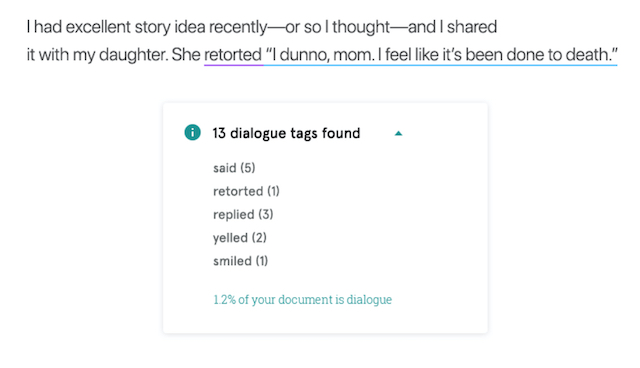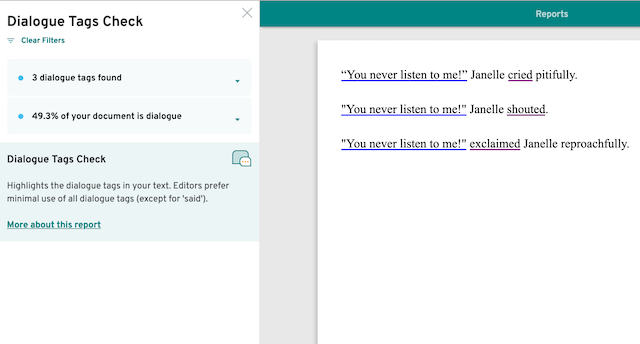
Dialogue is how your readers learn characters’ thoughts and sometimes their personality traits. You could have a quirky character who ends every sentence with, "ya see?" Or you could reveal backstory through dialogue.
Use dialogue to move your story forward, avoiding insignificant chatter. Your characters shouldn’t talk just to hear their voices. Your dialogue needs a purpose and strategy, unlike a lot of our real conversations.
The key to effective dialogue, though, is to manage your use of dialogue tags.
A dialogue tag is a verb that refers the sentence to a specific speaker or character. The most common dialogue tags are said and asked.
In fact, using other dialogue tags like shouted or squealed will brand you as a novice. And it’s worse if you add an adverb.
Examples of Dialogue Tags to Avoid
- "You never listen to me!" Janelle cried pitifully.
- "You never listen to me!" Janelle shouted.
- "You never listen to me!" exclaimed Janelle reproachfully.
These are distracting and have little real value. Using dialogue tags and adverbs tells your reader what you want them to understand about your character instead of showing them.
Let’s look at how ProWritingAid can help you out with this.
How to Use ProWritingAid’s Dialogue Check
Dialogue is one of many areas where ProWritingAid can help your writing shine. With the simple click of a button, you can learn instantly what dialogue tags you’ve used and where to find them. This helps you determine if you’ve used appropriate tags, if you shown rather than told, and if it’s clear who’s speaking.
Just head to "More Reports" and then hit "Dialogue." Click to run the report, and you’ll get something like this:

If you’re working on a long project, this will help you to click through your dialogue tags quickly so that you can see where you might need to make changes, saving time spent trawling through your manuscript yourself.
The Dialogue Check also calculates the percentage of your document that contains dialogue. Rarely do novels contain under 10% or over 80%. Somewhere in the middle is enough to move your readers along without boring them with too much narrative or inane chatter.
So, you’ve found your dialogue tags. Now what should you do with them?
Show Readers Through Actions and Dialogue
Instead of telling your reader what your character is feeling through dialogue tags, you should use dialogue with a character’s actions to move your story forward. If you want readers to learn more about Janelle and her situation, lose the tags.
- Janelle’s head drooped to let her bangs cover the sudden prickling of tears, and her voice dropped low. "You never listen to me."
The above show-don’t-tell version doesn’t use a dialogue tag, yet it’s clear who is speaking. And you learn more about Janelle from her actions.
If you want to make your editor and publisher happy, only use said or asked when it’s the only way to let the reader know who is speaking.
Analyze Your Writing Style
Do your characters tend to speak in lengthy monologues or pithy back-and-forths? The answer to that question is quite important.
If it’s the former, it might actually be correct to use dialogue tags. Imagine a detailed and profound monologue, followed by an awed response from another character, sans the dialogue tag. Sure, if there are only two characters in the scene, you might think it’s clear enough that Character 2 is speaking. But I’d argue the tag is worth it, just to keep the reader oriented. If there’s even the slightest confusion about who says what after long passages, it could weaken your writing.
However, if your dialogue tends to be snappy, you’re probably correct to excise dialogue tags. As mentioned, they’ll only slow your rhythm
Use Dialogue Tags for Emphasis
Sure, good dialogue shouldn’t need tags to explain a character’s tone. But dialogue can be made better with emphasis.
For example, take this line:
"Get out of there!"
As it stands, it’s pretty clear that the speaker has a frantic tone. But if we add a dialogue tag, we reinforce that notion.
"Get out of there!" Melinda roared.
I like the dialogue tag here because it gives us a concrete detail about Melinda’s tone. To me, there’s a difference between a yell, a bellow, a screech, and a roar. In this instance, we’re being precise about which we want. Without the tag, the reader might interpret the dialogue any number of other ways.
Dialogue Tags Aren’t Distracting if You Use Them Responsibly
Part of the reason dialogue tags have a bad reputation is that some writers use them irresponsibly. For example:
- "Dialogue tags are sacred," she intoned.
- "They tell you who’s talking," he expounded.
- "And what they’re saying," they elaborated.
I’m not saying you can’t use words like "intone" and "expound" in your work. But if every dialogue tag employs a different variation on the word "said," you’ve got a problem.
My advice: The vast majority of the time, "said" is the correct dialogue tag. Except when necessary to emphasize tone, deviations from that simple word cause unnecessary distraction.
Final Thoughts
Use ProWritingAid’s Dialogue Check to help you use dialogue effectively. Like everything else in life, avoid too much or too little. And when you absolutely need to use a dialogue tag, stick with said or asked. If you’ve been using tags and adverbs to prop up dialogue, you may have bigger problems to work on.
Good thing there’s ProWritingAid to help you, right?

